The Garden in Early Spring
The Museum’s garden is beginning to come to life for spring, and we thought you might like to see some photographs of it.
The dominant flower at the end of February was the snowdrop (Galanthus nivalis).
Clumps of it were in flower throughout the garden in the borders …
…but there were also drifts of these simple white flowers under the two ancient yew trees to the side of the house.
Other spring flowers in the borders included clumps of sweetly scented primroses (Primula vulgaris)
Lung Wort (Pulmonaria officialis)
And cheerful clumps of Crocus bulbs…before the birds attack them!
The Lenten Roses ( Helleborus orientalis) looked beautiful dotted in clumps among the border facing the house
The scented shrubs are still in bloom and on a warm, still day they scent the garden:
The lemon scented flowers of the Winter Flowering Honeysuckle are still attracting many bees on warm sunny days (of which we have had quite a few recently)
And the small clumps of Sarcococca (Sweet Box) with their tiny but pungent honey-sweet fragrance
scent the borders opposite the house entrance.
The fig tree , growing along the wall, is also showing promise for the late summer,
with its crop of tiny embryonic figs that have survived the winter and will either drop off or be picked off, to make room for this year’s new crop of fruit.
We shall follow the garden on the blog as it develops throughout the seasons, and we hope you will enjoy these virtual visits as much as our “real” visitors do.



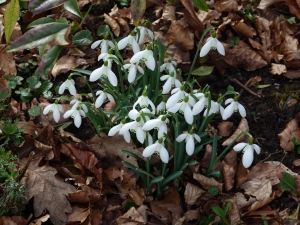


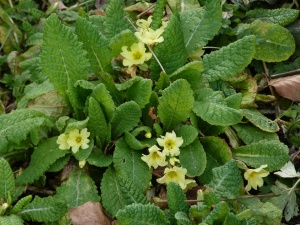






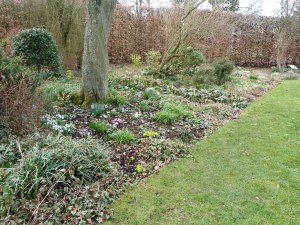
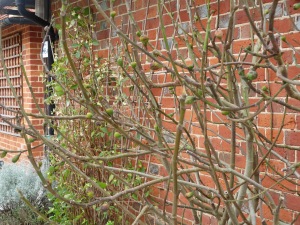


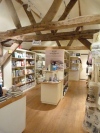
How long have the plants and flowers been in the garden…..do any stretch back to Jane austen’s time?
The yew trees are the oldest inhabitants of the garden.The garden is a modern attempt to recreate what it may have looked like when Jane Austen lived there from 1809-1817. Our gardener,Celia works very hard to try, as far as is possible, to use varieties of plants and shrubs that Jane Austen would had known, or which are appropriate for the setting.
Lovely!
Thank you- and thank you for taking the trouble to comment!
Lovely! Can´t wait to see this beautiful garden again in June!
It will look very different then ! Are you coming for a special visit or part of holiday trip?
It´s part of our holiday trip! Our last visit at the Jane Austen House Museum was so nice and so we decided to visit Chawton again 🙂
Here is a photo from our last visit: http://www.kleidertruhe.at/fotoalbum/janeausten10/tag2/janeaustenshousemuseumchawton5.jpg
Looking forward, Julia
How lovely you look! And you also look as if you had a wonderful time! We do hope your visit in the summer will be as much fun.
Yes I was wondering the same thing as the first comment. I suppose the yews must have been there in Jane’s day, and I imagine all the native species shown on your photos probably made and appearance, but is there much evidence for what was there in her day??? Were there any vegetables, did they keep a pig?!! etc etc
There are many references to the garden at Chawton in Jane Austen’s letters and in Edward Austen-Leigh’s Memoir of his aunt, and you might care to look out for them. For example, in her letter to her sister, Cassandra Austen dated 29th May 1811 Jane Austen wrote:
`Our young Piony(sic) at the foot of the Fir tree has just blown & looks very handsome;& the whole of the Shrubbery Border will soon be very gay with Pinks and Sweet Williams, in addition to the Columbines already in bloom. The Syringas too are coming out
They grew vegetables and fruit at Chawton too- there are again many mentions of this in Jane’s letters.
Thank you for typing that all out for me…I will go and look. I have many books but a very poor memory!!
LOL- that applies to us all. It was my pleasure!
Love the snowdrops. Spring begins muted and soft…
They are very special- very early to flower and consequently, very precious after a hard winter 😉
Thanks for sharing these lovely early spring glimpses. I have only been in the garden in summer so it is wonderful to see this view. Looking at the upcoming events, have you ever considered recording or streaming the speeches so those of us ‘across the pond’ would be able to listen? I would love to hear Maggie Lane.
Thank you! We thought you might all enjoy seeing the garden develop through the year.
No, we have no plans at present to “stream” our events, but we will be covering them, in some detail, on the blog, so do come back or subscribe so that you can look out for our reports!
Thanks for the photos! Spring in northern California is a lot different. We tried to grow snowdrops once, but it is too warm. Our primroses don’t have a scent. And I have never seen our crocus bulbs attacked by birds! Maybe we were just lucky!
The primroses have a very elusive scent, but if you get close enough to them, it is certainly there ! I didn’t know you couldn’t grow snowdrops in California. I’d miss them I think. Sparrows are the usual suspects regarding crocus flowers: they don’t seem to discriminate between any of the colurs-purple,white or yellow! Thank you very much for taking the time to comment.
Thank you, thank you for sharing these photos. It’s unseasonably warm here, and some blooming already in motion but these delicate flowers make my day!
Thanks Lucy! They are delicate and yet sturdy enough to emerge in the late winter/ early spring when the weather can be changeable!
Lovely, lovely, thank you! I’m in Southern California, and I’ve never even seen a Snowdrop, except in photographs. I do have a beautiful yellow Primrose plant on my desk right now, thanks to one of our teachers. The gardener, Celia, sounds like a real gem; thank her for me, too, please!
I will glady pass on your comments,Cathy. Celia looks after the garden in a splendid, caring way,and as you can see, the results speak volumes.
Very lovely to see Spring emerging there in the garden, and I will look forward to more seasons being shown as the calendar moves along, thank you, Julie and Celia. Good to read extra info in the comments section as well, I was curious also as to which trees date from JA time.
Yes, it is lovely to see the flowers emerge after the winter. It’s always wonderful to see the snowdrops. Thank you taking the trouble to comment, Moni. Do come back in a few weeks time for more on the garden.
Loveliest pictures 🙂 I feel like I’ve been in the garden… 😀 You’ve caught practically every beauty spring offers us… So alive and green and only the middle of March… Thank you very much..
We are so glad you enjoyed this post, do look out for more over the year.